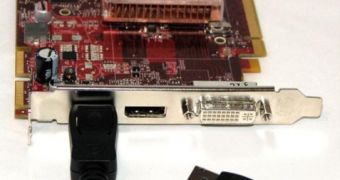The DisplayPort format parents have released the complete picture of the standard that will help hardware manufacturers include it into their products. The DisplayPort group also demonstrated working chips and complete systems produced by various technology partners.
The new interconnection standard has been designed to replace the older DVI, VGA and LVDS interconnects in desktops, notebooks and LCD monitors, but as it is becoming more and more popular, the standard might arrive in digital televisions as well. "Last year we had papers and promises and today we have working products," said Bob Myers, display technologist from Hewlett-Packard, speaking at a press conference about DisplayPort at CES.
During the press conference, major chip manufacturers (including Advanced Micro Devices, Intel, Integrated Device Technology, Genesis Microchip and Parade Technologies) demonstrated their own working DisplayPort chips. Dell showed a ready-to-go 30-inch LCD monitor to offer the new external DisplayPort interface.
Samsung demonstrated a viable replacement for the LVDS - a DisplayPort prototype that can work both internally or externally. The original backers of the standard have successfully demonstrated a prototype projector using DisplayPort.
Intel could not miss the show and presented a next-generation Cantiga PC chipset with DisplayPort support. The chipset is targeted at both desktop and notebook markets and is scheduled for shipment within a month. Apart from the DisplayPort interface, the Cantiga also supports the older HDMI, DVI and VGA interconnects, but the new standard will be the primary interconnect routed to an external port on Intel motherboards.
"This will become the display equivalent of Ethernet," said Bruce Montag, a system architect at Dell Computer who chairs the DisplayPort committee at the Video Electronics Standards Association. It is highly likely that the DisplayPort interface will transcend its PC usage and will be adopted by television set manufacturers, as its architecture is more elegant for high resolution displays compared to LVDS' eight links for a high-end 60 Hz 4Kx2K display.

 14 DAY TRIAL //
14 DAY TRIAL //